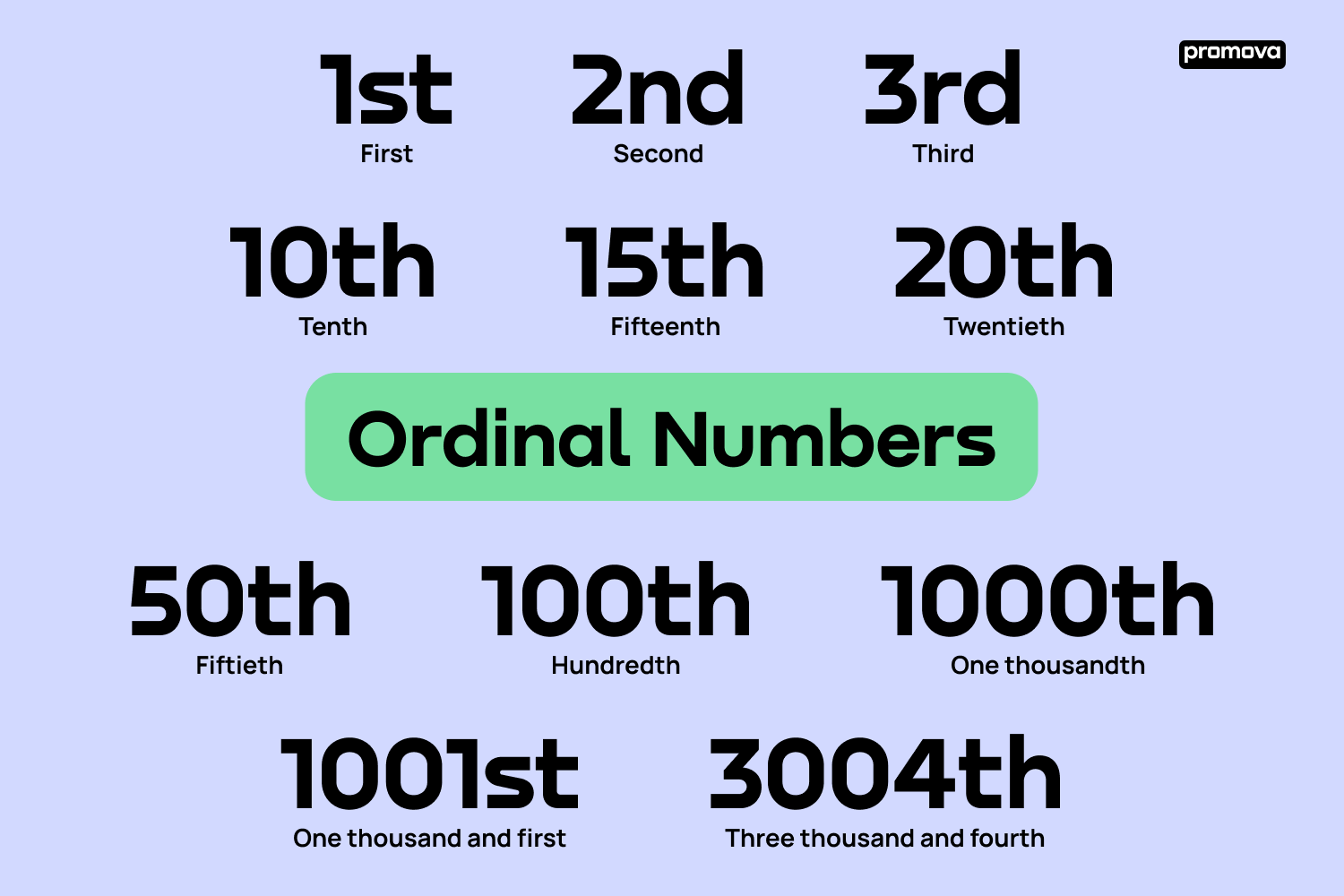Vocabulary of Ordinal Numbers in English
Contents
If you're learning English and want to master counting or arranging items in a sequence, understanding ordinal numbers is key. This guide aims to demystify the concept, equipping you with the right vocabulary and increasing your confidence in using these numbers in daily communication. 
What is an Ordinal Number?
An ordinal number denotes the position or order of an item in a list or series, indicating its rank in a sequence rather than the quantity, which is the role of a cardinal number. For instance, if you're looking at a line of people and asked to identify the "5th in words," you would say "fifth." This concept is a cornerstone of numerical vocabulary in English and many other languages.
Ordinal Numbers From 1 to 20
Before we delve into larger numbers, let's start with the basics: ordinal numbers from 1 to 20. It's where we encounter some irregularities, including the "first number," or "first," and the sequence "first, second, third, fourth," and so on.
| Number | Word |
| 1st | First |
| 2nd | Second |
| 3rd | Third |
| 4th | Fourth |
| 5th | Fifth |
| 6th | Sixth |
| 7th | Seventh |
| 8th | Eighth |
| 9th | Ninth |
| 10th | Tenth |
| 11th | Eleventh |
| 12th | Twelfth |
| 13th | Thirteenth |
| 14th | Fourteenth |
| 15th | Fifteenth |
| 16th | Sixteenth |
| 17th | Seventeenth |
| 18th | Eighteenth |
| 19th | Nineteenth |
| 20th | Twentieth |
Having a grasp on the ordinal numbers from 1 to 20 is pivotal in understanding the foundation of English numerical vocabulary. These numbers come up frequently in everyday speech and writing, such as describing order in a queue or ranking in a competition. By mastering these, you've successfully taken the first big step in understanding English ordinal numbers.
12
Ordinal Numbers in Multiples of 10
After mastering the first 20 ordinal numbers, it's time to consider larger numbers, specifically multiples of 10. These are slightly more straightforward, following a regular pattern.
| Number | Word |
| 10th | Tenth |
| 20th | Twentieth |
| 24th | Twenty-fourth |
| 30th | Thirtieth |
| 40th | Fortieth |
| 50th | Fiftieth |
| 60th | Sixtieth |
| 70th | Seventieth |
| 80th | Eightieth |
| 90th | Ninetieth |
| 100th | Hundredth |
Getting comfortable with the ordinal numbers in multiples of 10 is a crucial milestone. These numbers regularly appear in various contexts, such as anniversaries or important milestones. Being able to identify and use these terms with confidence will undoubtedly enhance your English communication skills, allowing you to converse more fluently and naturally.
Hundreds of Ordinal Numbers 100 to 1000
Now, let's move on to the hundreds in our journey through "numbers 1 to 100" and beyond, to 1000. These also follow a pattern, using the cardinal number and adding "-th" at the end.
| Number | Word |
| 100th | One hundredth |
| 101st | One hundred and first |
| 200th | Two hundredth |
| 254th | Two hundred and fifty-fourth |
| 300th | Three hundredth |
| 400th | Four hundredth |
| 500th | Five hundredth |
| 600th | Six hundredth |
| 700th | Seven hundredth |
| 800th | Eight hundredth |
| 900th | Nine hundredth |
| 1000th | One thousandth |
Mastering hundreds in ordinal numbers, all the way up to 1000, shows significant progress in your English numerical vocabulary. In the context of historical years, significant milestones, or large datasets, these numbers become quite important. With the ability to recognize and use these, you'll be well-equipped to tackle most numerical sequences you'll encounter in English texts or conversations.
Larger Ordinal Numbers
When you get to larger ordinal numbers, they're usually a combination of smaller ones you've already learned. They often follow patterns based on the last two digits.
| Number | Word |
| 1001st | One thousand and first |
| 1022nd | One thousand and twenty-second |
| 1155th | One thousand one hundred fifty-fifth |
| 2123rd | Two thousand one hundred twenty-third |
| 3004th | Three thousand and fourth |
When you understand larger ordinal numbers, it's a clear sign you've gone beyond the basics. These numbers may seem intimidating initially, but they're mostly combinations of smaller ordinal numbers you've already learned. Navigating these complex figures with ease is a testament to your command over the language, enabling you to communicate complex numerical concepts or sequences in English effectively.
Conclusion
Ordinal numbers may initially seem challenging, but they're largely about recognizing patterns and applying the rules consistently. From the first ordinal number to the larger ones, like numbers 1-100 and beyond, mastering these can significantly improve your English proficiency. Just remember, practice makes perfect, and before long, you'll find yourself effortlessly using ordinal numbers in your everyday English conversations.
Comments